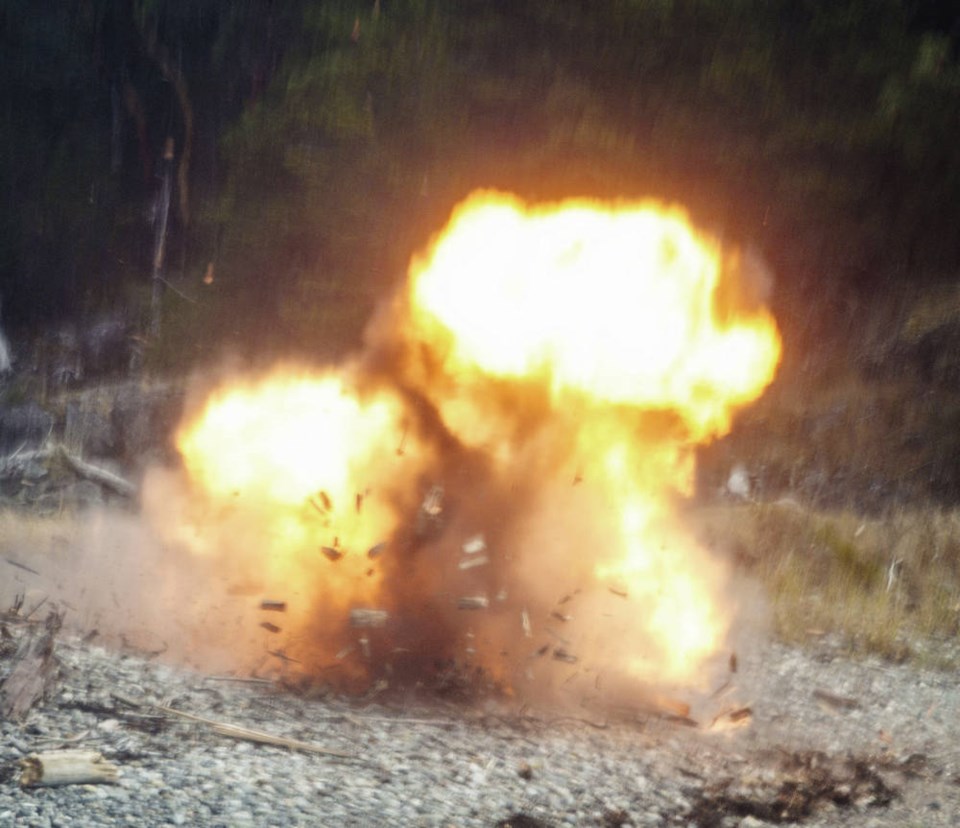The Royal Canadian Navy has been setting off explosives on Bentinck Island for more than a half century, using the former leper colony and its scrubby landscape as a training site to prepare its sailors for missions around the world.
And when blasting resumes on Monday and Tuesday, it is well aware of the outside scrutiny and the potential impact on marine life.
Bentinck lies a few hundred metres off Rocky Point in Metchosin and 1.5 nautical miles from Race Rocks Ecological Reserve, a significant feeding and gathering area for sea lions, seals, otters and birds, and along a major highway for humpback whales and resident and transient orcas.
The surface detonations of C4 explosives will continue over two days with several blasts from early morning until late afternoon. Nearby residents will likely be unaware of the activities except on days when environmental conditions such as temperature, humidity and wind direction affect how far the sound travels.
But on the water, eyes will be on marine life as the navy tightens its protocols on protection.
Lieutenant-Commander Anthony Wright, senior public affairs officer for the Canadian Armed Forces, said the navy has conducted extensive acoustic tests on noise measurements both in and above the water around Bentinck. Based on that data, it has developed “a marine mammal mitigation avoidance zone” to limit acoustic impacts on marine mammals.
That zone is a 2,000-metre ring around the demolition site, which is monitored by two sentries in small boats as well as an expert third-party marine mammal observer deployed at the perimeter for the duration of the training event. Their task is to search for marine mammals in or moving toward the zone.
Wright said when marine mammals are detected, all training ceases until they have passed safely through the area. Blasting doesn’t resume until the contracted observer gives an “all-clear,” he said.
Several members of the whale-watching community will also monitor and the navy has asked the Canadian Coast Guard marine mammal monitoring unit to track all possible whales in the vicinity.
The whale-watching industry has shared with the navy its closely held database of daily whale locations, gathered by a series of land and water spotters who cover a wide area of the south Island and almost always guarantee their clients a chance to encounter whales.
Two incidents in August 2017 brought the navy’s blasting under heavy criticism when a detonation went off while whales were in the Bentinck area.
Whale-watching skippers confronted navy sentries posted in watch boats off the island during blasting sessions that year, trying to convince the sentries to call off the blast because orcas were nearby.
But the whale watchers were told it was too late. The fuse was already lit. According to the whale-watching skippers, when the explosions occurred minutes later, the whales showed distress.
Acoustic vibrations from blasting can interfere with and harm whales, who are echo-locaters and find food and make their way around underwater obstacles using sound and echoes.
Dan Kukat, owner of Spring Tide Whale Watching and chairman and navy liaison for the Pacific Whale Watch Association, said human error can happen, but the navy has taken several steps to mitigate harm for marine life over the years.
Those include wider perimeters, more eyes in the area and reducing explosives in each blast. “The navy has taken great strides in the right direction. They have evolved, not devolved, in this matter.”
The navy is using a maximum of four blocks, or about five pounds, of C4 explosive per blast.
Kukat said that’s about half of what the navy has used in years past.
“They used to use up to 10 pounds for each blast and I remember feeling and hearing those downtown, 15 kilometres away,” he said.
Kukat noted the whale watch association has a “hot line” directly to the navy about locations of whales and concerns. “It goes from their environmental officers right up the chain of command to the most senior officers,” said Kukat. “The command takes this very seriously.”
Kelley Balcomb-Bartok, communications director for the Pacific Whale Watch Association based in Friday Harbor, Washington, said land and air explosions by both Canadian and U.S. navies “won’t be as impactful as blasts underwater,” but any loud noises will still cause whales to clear out of an area.
Balcomb-Bartok said the three pods of the endangered southern resident killer whales have not been spotted in the Salish Sea since April 10, when J-Pod turned up around the San Juan Islands.
He believes the whales are feeding south along the Washington coast or on the north and west side of Vancouver Island.
But orca transients and humpback whales are active in the Strait of Juan Fuca, he said.
Wright said the Bentinck Island demolitions range is an essential part of a sailor’s training.
“The training provides the ships of the navy a unique capability,” he said. “Having an organic demolitions capability enables deployed ships to safely and efficiently dispose of anything from a floating navigation hazard, such as a hulk or abandoned vessel, to a seized cache of illicit drugs, or to clear obstructions from a shoreline.”
The two days of live blasting are the final part of a six-day basic demolitions course that includes theory and practical training.
Wright said detonations are set off with electrical charges and blasting caps attached to lengths of fuse.
“The students practise live demolitions, ranging from very simple detonations for the more junior sailors to more complex projects involving the destruction of wood, metal, or concrete targets for more senior sailors,” said Wright.
All explosions are overseen by skilled instructional staff with years of combined experience in demolitions and teaching, he said.



